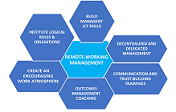Global Strategic Human Resource Management Practices and Systems Considerations for Virtual, Remote-Working Employees in COVID-19 Pandemic Era: A Triangulation of Meta-Methods

Abstract:
Virtual organisations have
progressively pervaded the world where groups of workers implement boundaryless,
concurrent, and cooperative job processes outside physical job environments. This
is made possible by internet accessibility; and information, communication, and
technology (ICT) which organises and integrates employees’ abilities and assets
for the sole purpose of achieving the overall organisational goal. Virtual jobs
offer fresh management problems in comparison to conventional in-person job habits.
Human
resource specialists reveal that various managers suffered from deficient capabilities
and power during COVID-19 lockdown in comparison to conventional working environment
management. A meta-evaluative research was conducted in order to conceptualize an
evidence-based synopsis on virtual administration of remote-working employees and
propose an applicable conceptual framework. The research utilised sixteen peer-reviewed
published articles on management of virtual remote-working employees between 2020
and 2023. The results were able to systematically demonstrate remote working procedures
of diverse organizations facilitated by virtual processes and technologies, and
strategic human resources management model as well as collaborative methodologies
that empowered the peculiar COVID-19 virtual workspaces. Communication, information
technology and managerial proficiencies are paramount for managers of employees
in such settings. Consequently, a conceptual framework for management of remote-working
employees have been designed containing managerial expertise, trainings, ICT and
environmental components. Managers are required to have the necessary abilities
required to anticipate diverse circumstances and to prepare beforehand activities
that counter likely contradictions and disputes. Virtual remote-working groups deliver
great prospects; thus, managers should aim to capitalise on its benefits while seeking
to minimise its drawbacks.
References:
[1] Carroll,
J. M., & Wang, J. (2011). Designing Effective Virtual Organizations as Sociotechnical
Systems. 44th Hawaii International Conference on System Sciences. Kauai, HI, USA,
4-7 January. USA, HICSS, 1-10.
[2] Törmänen,
M. (2017). Virtual Teams: Considerations, Advantages and Disadvantages [master’s
Thesis, Lappeenranta University of Technology, Finland]. https://lutpub.lut.fi/handle/10024/135203.
[3] Lee-Kelley,
L., & Sankey, T. L. (2008). Global Virtual Teams for Value Creation and Project
Success: A Case Study. International Journal of Project Management, 26(1),
pp.51-62. doi: 10.1016/j.ijproman.2007.08.010.
[4] Allen, T.
D., Golden, T. D., & Shockley, K. M. (2015). How Effective is Telecommuting?
Assessing The Status of Our Scientific Findings. Psychological Science in The
Public Interest, 16(2), 40-68. https://doi.org/10.1177/1529100615593273.
[5] Wang, B.,
Liu, Y., Qian, J. & Parker, S. K. (2020). Achieving Effective Remote Working
During The COVID-19 Pandemic: A Work Design Perspective. Applied Psychology:
An International Review, 0(0), 1-44. doi:10.1111/apps.12290.
[6] Eurofound
(2020). Living, Working and COVID-19, COVID-19 Series. Luxembourg: Publications
Office of the European Union.
[7] Ceurstemont,
S. (2020, 01 September). Teleworking is Here to Stay – Here’s What It Means for
The Future of Work. https://ec.europa.eu/research-and-innovation/en/horizon-magazine/teleworking-here-stay-heres-what-it-means-future-work
[8] Galanti,
T., Guidetti, G., Mazzei, E., Zappalà, S., & Toscano, F. (2021). Work From Home
During The COVID-19 Outbreak: The Impact on Employees’ Remote Work Productivity,
Engagement, and Stress. Journal of Occupational and Environmental Medicine,
63(7), e426-e432. https://doi.org/10.1097/JOM.0000000000002236.
[9] Storey,
J., Wright, P. M., & Ulrich, D. (2019). Strategic Human Resource Management:
A Research Overview (1st edn). Routledge.
[10] Armstrong,
M., & Taylor, S. (2014). Armstrong’s Handbook of Human Resource Management
Practice (13th ed). KoganPage.
[11] Zigurs,
I. (2003). Leadership In Virtual Teams: Oxymoron or Opportunity? Organizational
Dynamics, 31(4), 339-351. doi: 10.1016/S0090-2616(02)00132-8.
[12] Bisbe, J.,
& Sivabalan, P. (2017). Management Control and Trust in Virtual Settings: A
Case Study of a Virtual New Product Development Team. Management Accounting Research,
37, 12-29. https://doi.org/10.1016/j.mar.2017.02.001.
[13] Karoui,
M., Güerkan, A., & Dudezert, A. (2010). Virtual Team Collaboration: A Review
of Literature and Perspectives. 16th Americas Conference on Information Systems.
Lima, Peru, 12-15 August. Peru, pp.1-14.
[14] Nobari, A. R.,
Seyedjavadin, S. R., Roshandel Arbatani, T., & Rahnamay Roodposhti, F. (2018).
Environmental
Concerns and Green Human Resource Management: A Meta-Synthesis. Iranian Journal
of Plant Physiology, 8(4), 2573-2576.
[15] Lazazzara, A., Tims, M., & De Gennaro, D. (2020). The Process
of Reinventing a Job: A Meta–Synthesis of Qualitative Job Crafting Research. Journal
of Vocational Behavior, 116(Part B), Article 103267. https://doi.org/10.1016/j.jvb.2019.01.001.
[16] Hoon, C.
(2013). Meta-Synthesis of Qualitative Case Studies: An Approach to Theory Building.
Organizational Research Methods, 16(4), 522-556. https://doi.org/10.1177/1534484319828865.
[17] Garavan,
T. N., McCarthy, A., & Carbery, R. (2019). An Ecosystems Perspective on International
Human Resource Development: A Meta-Synthesis of the Literature. Human Resource
Development Review, 18(2), 248–288. https://doi.org/10.1177/1534484319828865.
[18] Pigott, T. D., & Polanin, J. R. (2020). Methodological Guidance
Paper: High-Quality Meta-Analysis in a Systematic Review. Review of Educational
Research, 90(1), 24-46. https://doi.org/10.3102/0034654319877153.
[19] Andrade,
C. (2021). The Inconvenient Truth About Convenience and Purposive Samples. Indian
Journal of Psychological Medicine, 43(1), 86-88. Doi: 10.1177/0253717620977000.
[20] Vehovar,
V., Toepoel, V., & Steinmetz, S. (2016). Non-probability Sampling. In
Wolf, C., Joye, D., Smith, T.W., & Fu, Y. (Eds) The SAGE Handbook of Survey
Methodology (pp. 327-343). SAGE Publications Ltd. https://doi.org/10.4135/9781473957893.
[21] Patino,
C. M., & Ferreira, J. C. (2018). Inclusion and Exclusion Criteria in Research
Studies: Definitions and Why They Matter. Journal Brasileiro De Pneumologia :
Publicacao Oficial Da Sociedade Brasileira De Pneumologia E Tisilogia, 44(2),
84. https://doi.org/10.1590/s1806-37562018000000088.
[22] Kepes, S.,
Banks, G. C., McDaniel, M., & Whetzel, D. L. (2012). Publication Bias in the
Organizational Sciences. Organizational Research Methods, 15(4), 624–662.
https://doi.org/10.1177/1094428112452760.
[23] Tanpipat,
W., Lim, H.W., & Deng, X. (2021). Implementing Remote Working Policy in Corporate
Offices in Thailand: Strategic Facility Management Perspective. Sustainability,
13, 1284. https://doi.org/10.3390/su13031284.
[24] Daniels,
R.A., Miller, L.A., Mian, M.Z., & Black S. (2022) One Size Does NOT Fit All:
Understanding Differences in Perceived Organizational Support During the COVID-19
Pandemic. Business and Society Review, 127 (Suppl 1), 193-222. https://doi.org/10.1111/basr.12256.
[25] Pasquel
Cajas, A. F., Cajas Bravo, V. T., & Dávila Morán, R. C. (2023). Remote Work
in Peru During the COVID-19 Pandemic. Administrative Sciences, 13(2) 58,
1-25. https://doi.org/10.3390/ADMSCI13020058.
[26] Amano, H.,
Fukuda, Y., Shibuya, K., Ozaki, A., & Tabuchi, T. (2021). Factors Associated
with The Work Engagement of Employees Working from Home During The COVID-19 Pandemic
In Japan. Int. J. Environ. RES. Public Health, 18 (19), 10495. https://doi.org/103390/ijerph181910495.
[27] Toscano,
F., & Salvatore, Z. (2020). Social Isolation and Stress as Predictors of Productivity
Perceptions and Remote Work Satisfaction During The COVID-19 Pandemic: The Role
of Concern About the Virus in A Moderated Double Mediation. Sustainability,
12(23), 9804. https://doi.org/10.3390/su12239804.
[28] Raišienė,
A. G., Rapuano, V., Varkulevičiūtė, K., & Stachová, K. (2020). Working From
Home – Who is Happy? A Survey of Lithuania’s Employees During the COVID-19 Quarantine
Period. Sustainability, 12(13), 5332. https://doi.org/10.339/su12135332.
[29] Chu, AMY.,
Chan, TWC., & So, MKP. (2022). Learning From Work-From-Home Issues During The
COVID-19 Pandemic: Balance Speaks Louder Than Words. PLOS ONE, 17(1), e0261969.
https://doi.org/10.1371/journal.pone.0261969.
[30] Matli, W.
(2020). The Changing Work Landscape as a Result of the COVID-19 Pandemic: Insights
from Remote Workers Life Situations in South Africa. International Journal of
Sociology and Social Policy, 40(9/10), 1237-1256. Doi: 10.1108/IJSSP-08-2020-0386.
[31] Elsafty,
A. S., & Ragheb, M. (2020). The Role of Human Resource Management Towards Employees
Retention During COVID-19 Pandemic in Medical Supplies Sector – Egypt. Business
and Management Studies, 6(2), 50-59. https://doi.org/10.11114/bms.v6i2.4899.
[32] Akinnubi,
O. P. (2021) Assessment of Human Resource Management During COVID-19 Pandemic in
Private Universities in Kwara State, Nigeria. Skyline Business Journal, 17(2),
33-43. https://doi.org/10.37383/SB1170203.
[33] Minbaeva,
D.B., & Navrbierg, S.E. (2023). Strategic Human Resource Management in The Context
of Environmental Crises: A COVID-19 Test. Human Resource Management, 2023,
1-22. Doi: 10.1002/hrm.22162.
[34] Adisa, T.
A., Antonacopoulou, E., Beauregard, T. A., Dickmann, M., & Adekoya, O. D. (2022).
Exploring The Impact of COVID-19 on Employees’ Boundary Management and Work-Life-Balance.
British Journal of Management, 33, 1694-1709. Doi: 10.1111/1467-8551.12643.
[35] Agarwal,
P. (2021). Shattered but Smiling: Human Resource Management and the Wellbeing of
Hotel Employees During COVID-19. International Journal of Hospitality Management,
93, 102765. https://doi.org/10.1016/j.ijhm.2020.102765.
[36] Messabia, N., Fomi, P. R., & Koli, C. (2022). Managing Restaurants
During The COVID-19 Crisis: Innovating to Survive and Prosper. Journal of Innovation
& Knowledge, 7(4) 100234, 1-9. https://doi.org/10.1016/j.jik.2022.100234.
[37] Branicki,
L., Kalfa, S., & Brammer, S. (2022). Surviving COVID-19: The Role of Human Resource
Managers in Shaping Organizational Responses to Societal Paradox. British Journal
of Management, 33, 410-434. Doi: 10.1111/1467-8551.12570.
[38] Nutsubidze
& Schmidt (2021). Rethinking The Role of HRM During COVID-19 Pandemic Era: Case
of Kuwait. Review of Socio-Economic Perspective, 6(1),1-12. https://doi.org/10.19275/RSEP103.
[39] Parker,
S.K., Knight, C., & Keller, A. (2020, 30 July). Remote Managers Are Having Trust
Issue. https://hbr.org/2020/07/remote-managers-are-having-trust-issues.
[40] Savage,
M. (2021, 13 September). What Bosses Really Think About Remote Work. https://www.bbc.com/worklife/article/20210908-what-bosses-really-think-about-remote-work.

